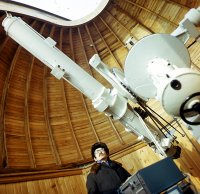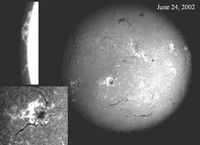Institute of Solar-Terrestrial Physics of Siberian Branch of Russian Academy of Sciences (ISTP SB RAS)
H-Alpha Telescope for the Full Solar Disc
From ISTP SB RAS
|
The refractor was developed and designed in ISTP SB RAS according to the original optical scheme. An interference-polarization filter (manufactured by Bernhard Halle Nachfl. GmbH, Germany) installed in the telecentric ray path allows us to observe the Sun in the H-alpha spectral line at 656.3 nm. Having the half-width of 0.05 nm, the filter passband can be displaced within ± 0.1 nm. The main parameters
|
|
In 1981-1999, 80-mm film was used to obtain images of the solar disc; there is a film archive. In 2000-2002, we used the Princeton Instruments CCD camera having 2048×2048 pixel array format. Image archive on FTP server. Since 2004, we have been using the 8-megapixel Konica Minolta DiMAGE A2 to observe separate active regions. |
|
The most significant results:
|
- This page has been accessed 6,716 times.


